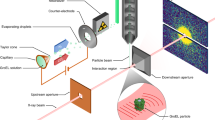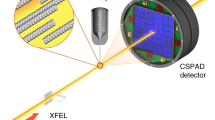Abstract
Moves are afoot to illuminate particles in flight with powerful X-ray bursts, to determine the structure of single molecules, viruses and nanoparticles. This would circumvent important limitations of current techniques, including the need to condense molecules into pure crystals. Proposals to reconstruct the molecular structure from diffraction ‘snapshots’ of unknown orientation, however, require ∼1,000 times more signal than available from next-generation sources. Using a new approach, we demonstrate the recovery of the structure of a weakly scattering macromolecule at the anticipated next-generation X-ray source intensities. Our work closes a critical gap in determining the structure of single molecules and nanoparticles by X-ray methods, and opens the way to reconstructing the structure of spinning, or randomly oriented objects at extremely low signal levels.
This is a preview of subscription content, access via your institution
Access options
Subscribe to this journal
Receive 12 print issues and online access
$209.00 per year
only $17.42 per issue
Buy this article
- Purchase on Springer Link
- Instant access to full article PDF
Prices may be subject to local taxes which are calculated during checkout




Similar content being viewed by others
References
Solem, J. C. & Baldwin, G. C. Microholography of living organisms. Science 218, 229–235 (1982).
Neutze, R., Wouts, R., van der Spoel, D., Weckert, E. & Hajdu, J. Potential for biomolecular imaging with femtosecond X-ray pulses. Nature 406, 752–757 (2000).
Miao, J., Hodgson, K. O. & Sayre, D. Extending the methodology of X-ray crystallography to allow imaging of micrometer-sized non-crystalline specimens. Proc. Natl Acad. Sci. 98, 6641–6645 (2001).
Huldt, G., Szőke, A. & Hajdu, J. Diffraction imaging of single particles and biomolecules. J. Struct. Biol. 144, 219–227 (2003).
Gaffney, K. J. & Chapman, H. N. Imaging atomic structure and dynamics with ultrafast X-ray scattering. Science 316, 1444–1448 (2007).
Chapman, H. N. et al. Femtosecond diffractive imaging with a soft-X-ray free-electron laser. Nature Phys. 2, 839–843 (2006).
Chapman, H. N. et al. Femtosecond time-delay X-ray holography. Nature 448, 676–679 (2007).
Gerchberg, R. W. & Saxton, W. O. A practical algorithm for the determination of the phase from image and diffraction plane pictures. Optik 35, 237–246 (1972).
Fienup, J. R. Reconstruction of an object from the modulus of its Fourier transform. Opt. Lett. 3, 27–29 (1978).
Sayre, D. in Imaging Processes Coherence in Physics Vol. 112 (eds Schlenker, M. et al.) 229–235 (Lecture Notes in Physics, Springer, 1980).
Miao, J., Charalambous, P., Kirz, J. & Sayre, D. Extending the methodology of X-ray crystallography to allow imaging of micrometer-sized non-crystalline specimens. Nature 400, 342–344 (1999).
Shneerson, V. L., Ourmazd, A. & Saldin, D. K. Crystallography without crystals. I. The common-line method for assembling a three-dimensional diffraction volume from single-particle scattering. Acta Crystallogr. A 64, 303–315 (2008).
Bortel, G. & Faigel, G. Classification of continuous diffraction patterns: A numerical study. J. Struct. Biol. 158, 10–18 (2007).
Honda, S., Yamasaki, K., Sawada, Y. & Morii, H. 10 residue folded peptide designed by segment statistics. Structure 12, 1507–1518 (2004).
Tenenbaum, J. B., de Silva, V. & Langford, J. C. A global geometric framework for nonlinear dimensionality reduction. Science 290, 2319–2323 (2000).
Donoho, D. L. & Grimes, C. Hessian eigenmaps: Locally linear embedding techniques for high-dimensional data. Proc. Natl Acad. Sci. 100, 5591–5596 (2003).
Bishop, C. M. Neural Networks for Pattern Recognition (Oxford Univ. Press, 1995).
Bishop, C. M. in Learning in Graphical Models (ed. Jordan, M. I.) 371–403 (MIT Press, 1999).
Svensen, J. F. M. The Generative Topographic Mapping. Thesis, Aston Univ. (1998).
Bishop, C. M. & Tipping, M. E. A hierarchical latent variable model for data visualization. IEEE Trans. Pattern Recognition Machine Intelligence 20, 281–293 (1998).
Howard, R. E., Jackel, L. D. & Graf, H. P. Electronic neural networks. J. Am. Telephone Telegraph Co. 67, 58–64 (1988).
Kuipers, J. B. Quaternions and Rotation Sequences (Princeton Univ. Press, 1999).
Oszlányi, G. & Sütő, A. Ab initio structure solution by charge flipping. Acta Crystallogr. A 60, 134–141 (2004).
Oszlányi, G. & Sütő, A. Ab initio structure solution by charge flipping. II. Use of weak reflections. Acta Crystallogr. A 61, 147–152 (2005).
Neutze, R., Huldt, G., Hajdu, J. & van der Spoel, D. Potential impact of an X-ray free electron laser on structural biology. Rad. Phys. Chem 71, 905–916 (2004).
Jurek, Z., Faigel, G. & Tegze, M. Dynamics in a cluster under the influence of intense femtosecond hard X-ray pulses. Eur. Phys. J. D 29, 217–229 (2004).
Acknowledgements
We acknowledge valuable discussions with M. Schmidt and P. Schwander. We are grateful to V. Elser for stimulating us to think about general methods for determining orientations, and to D. Starodub for the suggestion to consider the application of our approach to multicrystalline materials.
Author information
Authors and Affiliations
Corresponding author
Supplementary information
Supplementary Information
Supplementary Informations (PDF 487 kb)
Rights and permissions
About this article
Cite this article
Fung, R., Shneerson, V., Saldin, D. et al. Structure from fleeting illumination of faint spinning objects in flight. Nature Phys 5, 64–67 (2009). https://doi.org/10.1038/nphys1129
Received:
Accepted:
Published:
Issue Date:
DOI: https://doi.org/10.1038/nphys1129
This article is cited by
-
Cryo-EM, XFELs and the structure conundrum in structural biology
Nature Methods (2019)
-
Model-independent particle species disentanglement by X-ray cross-correlation scattering
Scientific Reports (2017)
-
Conformational landscape of a virus by single-particle X-ray scattering
Nature Methods (2017)
-
A comprehensive simulation framework for imaging single particles and biomolecules at the European X-ray Free-Electron Laser
Scientific Reports (2016)
-
XFEL data analysis for structural biology
Quantitative Biology (2016)



